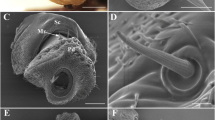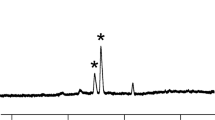Summary
Using the linked gas chromatographical/electroantennogram (GC/EAG) technique it was revealed that the reindeer warble fly (H. tarandi) was specifically able to sense the same components from reindeer interdigital pheromone gland as the reindeer nose bot fly (C. trompe) another reindeer endoparasite. These two species belong to the same family (Oestridae), but different subfamilies, and the evolution towards an endoparasitic life cycle is thought to have been independent. The development of olfactory abilities to find reindeer from long distances is hypothesized to have taken place through convergent evolution or exists because of their common ancestry.
Similar content being viewed by others
References
Anderson JR, Olkowski W (1968) Carbon dioxide as an attractant for host seekingCephenemyia females (Diptera: Oestridae). Nature 220:190–191
Anderson JR, Nilssen A (1985) The ecology and behaviour of the reindeer nose bot fly,Cephenemyia trompe (Modeer) and the reindeer warble fly,Oedemagena tarandi L. (Diptera: Oestridae). (Proc 12th Scand Symp Parasitol) Information (Inst Parasitol Åbo Akademi, Finland) 18:50
Anderson JR, Nilssen A (1990) The method by whichCephenemyia trompe (Modeer) larvae invade reindeer (Rangifer tarandus). Rangifer, special issue # 3:291–297
Andersson G, Brundin A, Andersson K (1979) Volatile compounds from the interdigital gland secretion of reindeer (Rangifer tarandus L.) J Chem Ecol 5:321–333
Bergmann AM (1917) Om renens oestrider. Entomol Tidskr 38:1–32, 113–146
Breyev KA, Karazeeva ZF (1957) Relating to the biology of the warble flyOedemagena tarandi L. III. Observations on the pupa and adult flies. (In Russian). Parazitologiceskij Sbornik Akad. Nauk SSSR. Moska Zoologiceskij muzei 17:199–228
Brundin A, Andersson G (1979) Seasonal variation of three ketones in the interdigital gland secretion of reindeer (Rangifer tarandus L.). J Chem Ecol 5:881–889
Bursell E (1984) Effects of host odour on the behaviour of tsetse. Insect Sci Appl 5:345–349
Colvin J, Gibson G (1992) Host-seeking behavior and management of tsetse. Annu Rev Entomol 37:21–40
Den Otter CJ, Van der Goes van Naters (1990) Single cell recordings from tsetse antennae. Chemical Senses
Folstad I, Nilssen AC, Halvorsen O, Andersen J (1989) Why do male reindeer (Rangifer t. tarandus) have higher abundance of second and third instar larvae ofHypoderma tarandi than females? Oikos 55:87–92
Gomoyunova NP (1976) Biologiya ovodov severnykh oleney. (In Russian). Novosibirsk: “Nauka”
Grunin KJ (1964–65) Hypodermatidae. Pp 1–160in Linder E (ed.) Die Fliegen der palaearktischen Region. Vol 8 (64b). D-Stuttgart: Schweizerbart'sche Verlagsbuchhandlung
Grunin KJ (1966) Oestridae. Pp 1–97in Linder E (ed.) Die Fliegen der palaearktischen Region. Vol 8 (64a). D-Stuttgart: Schweizerbart'sche Verlagsbuchhandlung
Guerin PM, Städler E, Buser HR (1983) Identification of host plant attractants for the carrot fly,Psila rosae. J Chem Ecol 9:843–861
Hadwen S (1927) Notes on the life history ofOedemagena tarandi L. andCephenomyia trompe Modeer. J Parasitology 13:56–65
Hadwen S, Palmer LJ (1922) Reindeer in Alaska. Bulletin 1089. Washington: United States Department of Agriculture
Hall DR, Beevor PS, Cork A, Nesbitt BF, Vale GA (1984) 1-octen-3-ol: a potent olfactory stimulant and attractant for tsetse isolated from cattle odours. Insect Sci Appl 5:335–339
Helle T (1980) Abundance of warble fly (Oedemagena tarandi) larvae in semi-domestic reindeer (Rangifer tarandus) in Finland. Rep Kevo Subarctic Res Stat 16:1–6
Kafka WA (1970) Molekulare Wechselwirkungen bei der Erregung einzelner Riechzellen. Z vergl Physiol 70:105–143
Kelsall JP (1975) Warble fly distribution among some Canadian caribou. Pp 509–517in Luick JR, Lent PC, Klein DR, White RG (eds) Proc 1st Intern Reindeer and Caribou Symp 1972. Fairbanks/AL: Univ of Alaska
KyorKu C, Brightwell R, Dransfield RD (1990) Traps and odour baits for the tsetse fly,Glossina longipennis (Diptera: Glossinidae). Bull Entomol Res 80:405–415
Mettler LE, Gregg TG, Schaffer HE (1988) Population Genetics and Evolution. 2nd ed. Englewood Cliffs/NJ: Prentice Hall
Mustaparta H, Angst ME, Lanier GN (1980) Receptor discrimination of enantiomers of the aggregation pheromone ipsdienol, in two species ifIps. J Chem Ecol 6:689–701
Nicolas G, Sillans D (1989) Immediate and latent effects of carbon dioxide on insects. Annu Rev Entomol 34:97–116
Nilssen AC, Anderson JR (1995) Flight capacity of the reindeer warble flyHypoderma tarandi (L.) and the reindeer nose bot flyCephenemyia trompe (Modeer) (Diptera: Oestridae). Can J Zool 73:1228–1238
Nilssen AC, Haugerud RE (1994) The timing and exit rate of larvae of the reindeer warble flyHypoderma ( =Oedemagena)tarandi (L.) and the reindeer nose bot flyCephenemyia trompe (Modeer) (Diptera: Oestridae) from the reindeer. Rangifer 14:113–122
Nilssen AC, Haugerud RE (1995) Epizootiology of the reindeer nose bot fly,Cephenemyia trompe (Modeer) (Diptera: Oestridae), in reindeer,Rangifer tarandus (L.), in Norway. Can J Zool 73:1024–1036
Nilssen AC, Tømmerås BÅ, Schmid R, Evensen SB (1996) Dimethyl trisulphide is a strong attractant for some calliphorids and a muscid but not for the reindeer oestrids Hypoderma tarandi and Cephenemyia trompe. Entomol exp appl: in press
Papavero N (1977) The World Oestridae (Diptera), Mammals and Continental Drift. Ser Entomol 14:1–145. NL-The Hague: W. Junk
Rognes K (1991) Blowflies (Diptera, Calliphoridae) of Fennoscandia and Denmark. Fauna Ent Scand 24:1–272. DK-Klampenborg: Scandinavian Sci Press
Saveljiev D (1971) Renstyngens biologi och kampen mot dessa insekter. Pp 84–86in Report from the Reindeer Symposium in Rovaniemi 26–27/5, 1971, SF-Helsingfors: Lantbruksarbetsgruppen inom Kommitten för ventenskaplig-teknisk samverkan mellan Finland och Sovjetunionen
Schmid R, Evensen SB, Tømmerås BÅ, Nilssen AC (in prep.) Chemical isolation and identification of potent olfactory stimulants for the nose bot flyCephenemyia trompe (Oestridae) from the interdigital pheromone gland of reindeerRangifer tarandus.
Sdobnikov VM (1935) Relations between the reindeer (Rangifer tarandus) and the animal life of tundra and forest. Trans Arctic Inst Leningrad 24:5–66
Tømmerås BÅ, Mustaparta H (1987) Chemoreception of host volatiles in the bark beetleIps typographus. J Comp Physiol A 161:705–710
Tømmerås BÅ, Wibe A, Nilssen A, Anderson JR (1993) The olfactory response of the reindeer nose bot fly,Cephenemyia trompe (Oestridae), to components from interdigital pheromone gland and urine from the host reindeer,Rangifer tarandus. Chemoecology 4:115–119
Vale GA, Hall DR (1985a) The use of 1-octen-3-ol, acetone and carbon dioxide in the attraction of tsetse flies,Glossina spp. (Diptera: Glossinidae), to ox odour. Bull entomol Res 75:209–217
Vale GA, Hall DR (1985b) The use of 1-octen-3-ol, acetone and carbon dioxide to improve baite for tsetse flies,Glossina spp. (Diptera: Glossinidae). Bull entomol Res 75:219–231
Vale GA, Bursell E, Hargrove JW (1985) Catching-out the tsetse fly. Parasitol Today 1:106–110
Warnes ML (1989) Responses of the tsetse fly,Glossina pallidipes, to ox odour, carbon dioxide and a visual stimulus in the laboratory. Entomol exp appl 50:245–253
Wood DM (1987) Oestridae. Pp 1147–1158in McAlpine JF (ed.) Manual of Nearctic Diptera. Vol 2. Ottowa: Research Branch Agriculture Canada
Zumpt F (1957) Some remarks on the classification of the Oestridaes. lat. (Diptera). J Entomol Soc S Afr 20:154–161
Zumpt F (1965) Myiasis in Man and Animals in the Old World. GB-London: Butterworth & Co.
Author information
Authors and Affiliations
Rights and permissions
About this article
Cite this article
Tømmerås, B.Å., Nilssen, A.C. & Wibe, A. The two reindeer parasites,Hypoderma tarandi andCephenemyia trompe (Oestridae), have evolved similar olfactory receptor abilities to volatiles from their common host. Chemoecology 7, 1–7 (1996). https://doi.org/10.1007/BF01240631
Issue Date:
DOI: https://doi.org/10.1007/BF01240631




